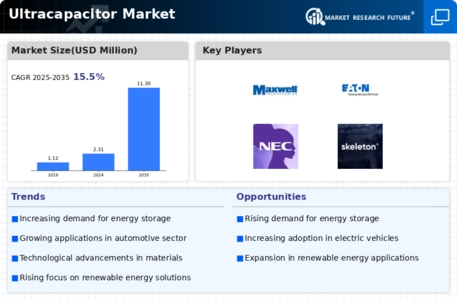Market Trends
Key Emerging Trends in the Ultracapacitor Market
There are a considerable number of trends that have been observed in the Ultracapacitor market that; by changing it, contributing to adjusting the energy storage. A significant development in trend is the ever-increasing demand for ultracapacitors (cap example: nano, gels) in electric vehicles (EVs) and hybrid electric vehicles (HEVs). Ultracapacitors are becoming increasingly popular in the automotive sector as transport systems change towards cleaner and more renewable forms of transportation, including charging remarkably fast within an incredibly short period and discharging it completely efficiently to serve energy storage for regenerative braking applications and high-motor acceleration rates. This is one of the trends that are leading to the development of ultracapacitors in not only switching functions but also as a critical element in electrification for the automotive industry.
In addition to this, the incorporation of ultracapacitors in renewable energy systems is gradually picking up. Since global efforts towards renewable energy sources increase and the world moves to that direction, ultracapacitors smooth out the erratic nature of power generation from such resources with their rapid bursts of stored energy in periods where they are needed other than ensuring grids. This tendency coincides with the worldwide attempt towards green sources of energy and points out on an exceptional case with ultracapacitors supporting renewable energies incorporation. Other productivity trends within the Ultracapacitor market include non-transportation or renewable energy storage applications. It is gradually seeing increased use in industries like consumer electronics, industrial machinery and telecommunication for their density high power, long cycle life and fast response times.
The diversification of applications also reveals the flexibility and effectiveness Ultracapacitors are utilized across industries range thus increasing the market share of Ultracapacitor use. In addition, the innovation in technologies makes a rising environment for better efficiency and cost effectiveness of ultracapacitor. The continuous investment of time and money include different developmental processes aimed at improving the energy density level of ultracapacitors in order for them to become better than traditional batteries. Materials and production innovations are leading the revolution of these components (ultracapacitors), making them more attractive for various other spheres and broadening the market place.
Energy efficiency and sustainability are becoming key elements of the market for the Ultracapacitor, which is indicative of several emerging trends adopted in producing these energy-saving devices. By implementing ultracapacitors as a result the industries will overcome ways of lower down on carbon footprint and improve all around energy productiveness.







Leave a Comment